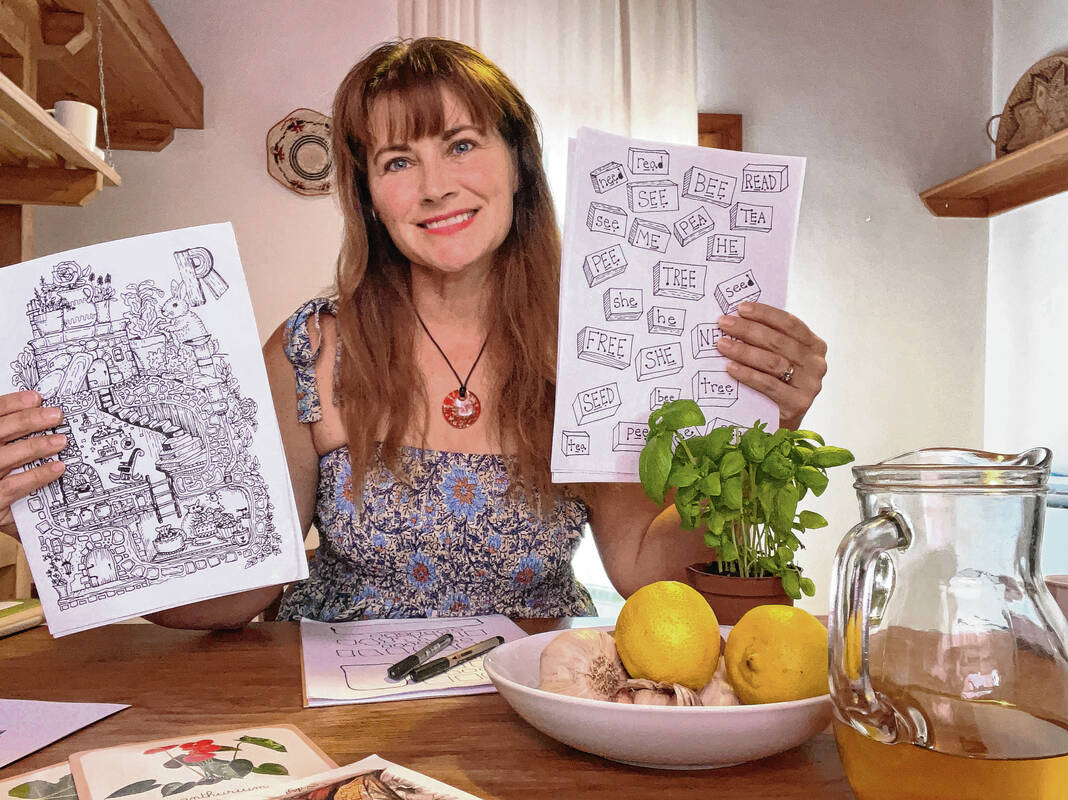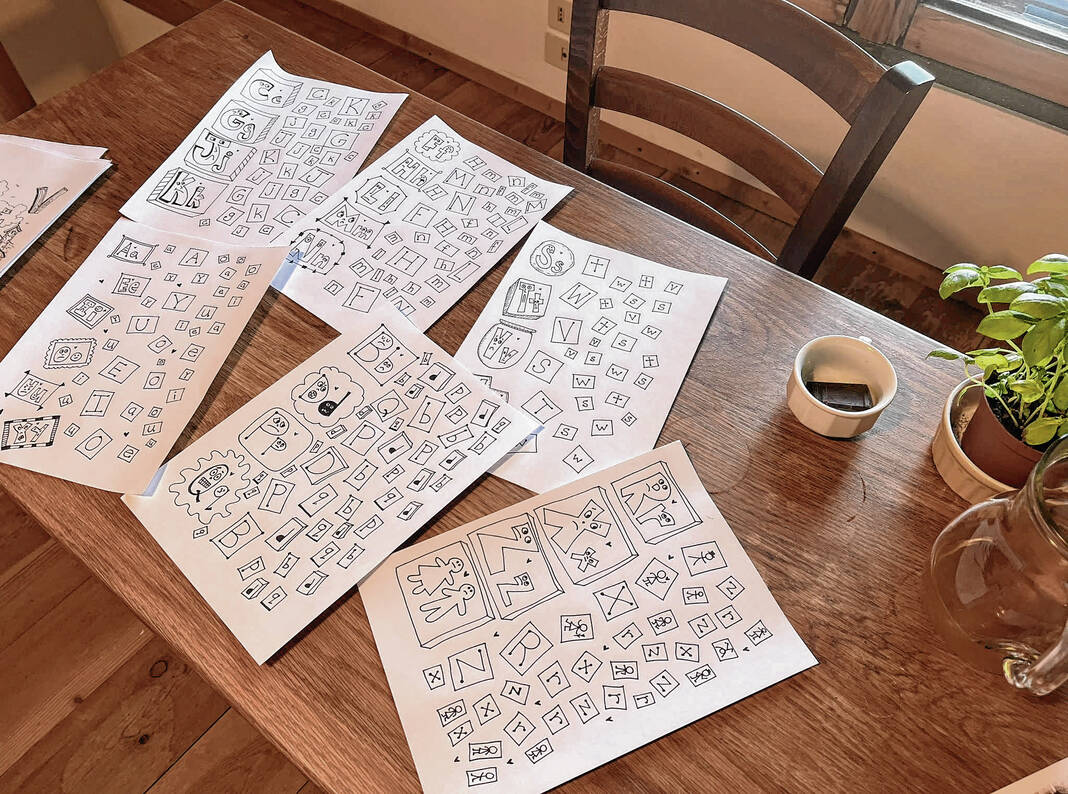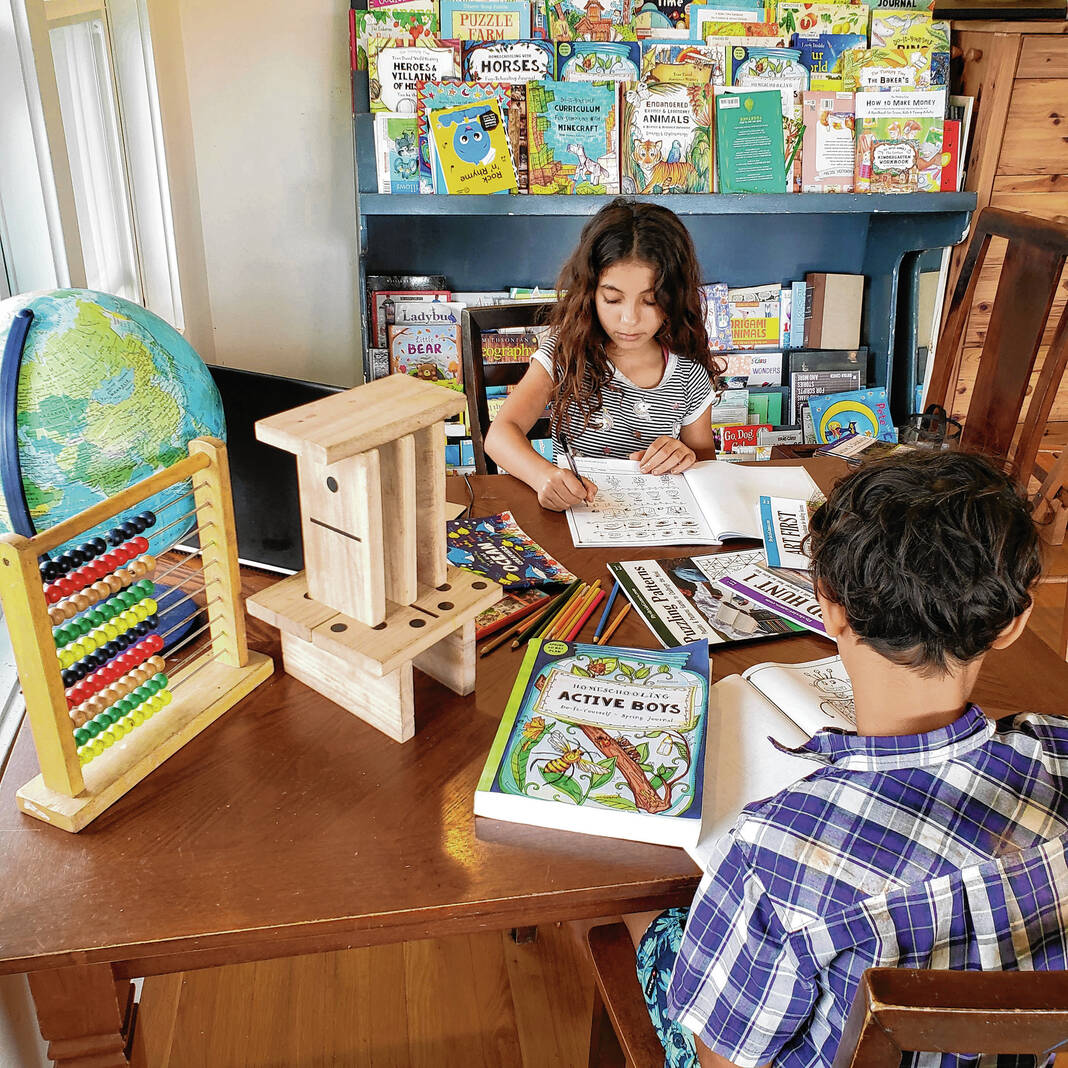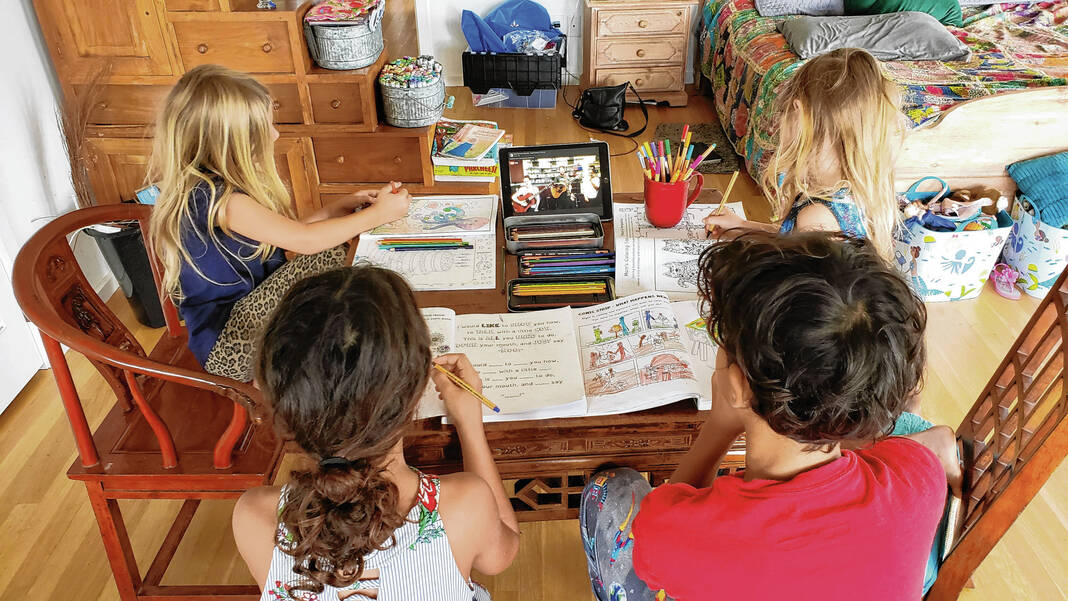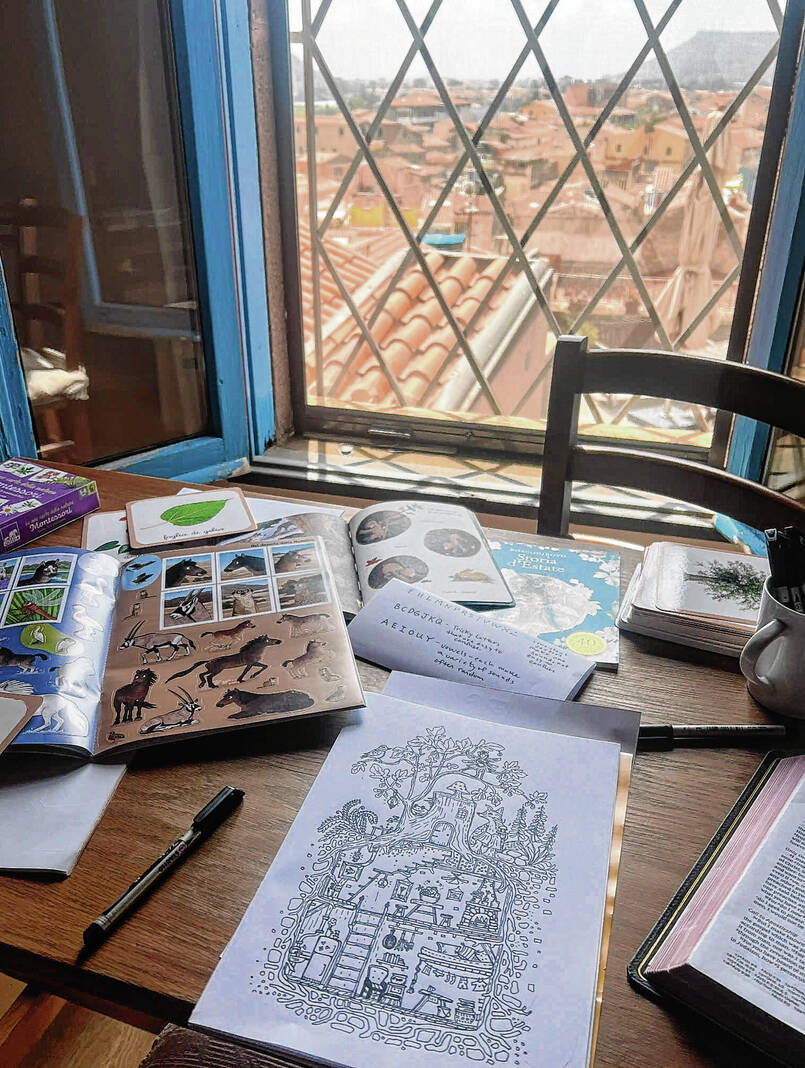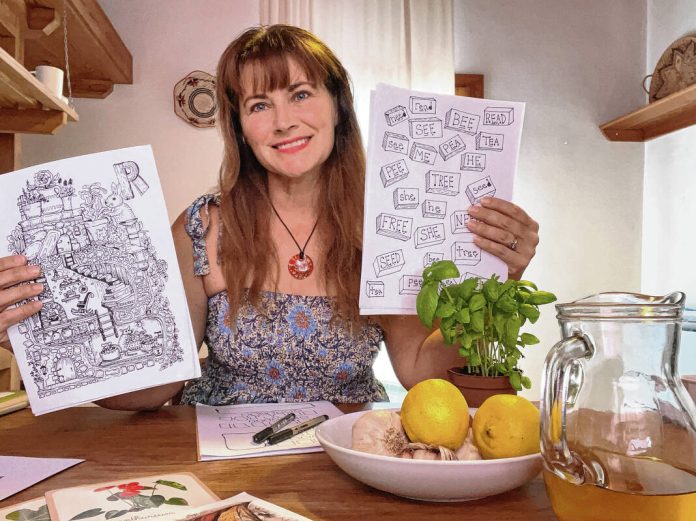
Sarah Janisse Brown, a Center Grove-area resident and publisher who has developed more than 300 workbooks for non-traditional learners, holds up worksheets she created for a new reading curriculum while staying in Bosa, a village on the island of Sardinia in Italy during the month of July. The curriculum is aimed at using logic and puzzles to help teach reading components. SUBMITTED PHOTO
There had to be a better way for kids to learn.
Sarah Janisse Brown was sure of it. The Center Grove-area resident watched as her children, some of whom struggled with dyslexia, were lost in the traditional approach to reading. Some of her other children, who had been adopted from Ukraine, were unfamiliar with the alphabet and found it hard to grasp.
The existing way to teach them wasn’t working. So she set out to create her own approach.
“What if there was a beginner’s reading curriculum that set the kids up for success? This way we wouldn’t need so much remedial instruction,” said Brown, a publisher who has developed more than 300 workbooks for non-traditional learners. “I also wanted to make sure the new curriculum could be easily used with children who speak English as a second language.”
Brown is in the process of developing a curriculum designed to teach the alphabet, letter sounds, beginning phonics, writing, vocabulary and more for kids ages 4 to 7. Her hope is to inspire creative mastery of the tricky words and letters that populate the English language and commonly trip up beginning readers in their school work.
Using logic and puzzles, the system presents a better approach for learning for some kids.
“The many children I work with have complained that the curriculum in school is boring, babyish and confusing,” she said in an email. “Kids love my curriculum because the activities are easy to understand, logical, and the artwork is engaging. I use logic puzzles and art games to build a vast number of skills that are foundational to reading.
“It’s brain work.”
Life can get fairly crazy in Brown’s household. She and her husband, Josh, live on a working farm and own a publishing company. They have 15 children, ages 9 to 25, and the family is involved in mission work in their free time.
As the idea to create a reading curriculum coalesced, Brown knew she had to find someplace quiet. She found it in the quaint village of Bosa, situated on the Temo River on the Italian island of Sardinia.
With her husband and younger children spending time in Holland, her teenage kids on mission trips and her older daughters operating the farm, Brown was able to focus entirely on her project.
“When I want to work on a project like this I must be 100% engaged. I need to get into the flow. So spending time alone in a charming village in Europe is a perfect way to make it happen,” she said. “And I am one who is inspired by beauty and fueled by fresh Mediterranean cuisine! I needed to get alone in my favorite place to launch this project.”
Brown’s journey into new ways of learning started in 2009. She and her husband, Josh, found out their 8-year-old daughter had dyslexia. She was perplexed as to how her daughter could make beautiful, complex pieces of art, but struggle so much with basic reading.
Her research on how the brain creates neural pathways for literacy blossomed into a therapy to help people with dyslexia learn to read. Dyslexia Games combined art and puzzle games that engaged readers who were struggling, helping them grasp the concepts of reading.
Since its debut in 2010, Brown has seen her workbooks and materials used by tens of thousands of struggling readers in public, private and home schools around the world.
But beyond children with dyslexia, she sees the potential to help a wide variety of learners.
“I now work with thousands of children who have been through the system for many years and still can’t read. Since moving back to Indiana in 2021 I have learned that a large percentage of our children in public schools are not proficient in reading on grade level,” she said. “…I want to bring together everything I’ve learned to create a kindergarten curriculum that reduces confusion while tapping into the student’s creativity, logic skills, and thirst for learning.”
Many of Brown’s own children have benefited from the approach. She and Josh have 15 children, including five who struggle with dyslexia. Five other kids, adopted from Ukraine, had to learn English from scratch.
“As I worked with each child I saw patterns of confusion when the letters and phonetically sounds were introduced in alphabetical order,” she said.
Of particular difficulty were the first five letters of the alphabet.
“The letters ‘b’ and ‘d’ confuse dyslexic children because of the design of the lowercase symbols, and how vastly different they look from their uppercase match,” Brown said. “Then ‘a,’ ‘c’ and ‘e’ represent several different sounds, so beginner readers are immediately confused by the sounds these letters are supposed to make, because they often break the rules of phonics.”
So in Brown’s curriculum, the approach is teaching the letters that represent one sound first, before moving on to the more difficult ones.
A key vehicle for the approach is artwork. Her research and experience has shown that children respond to complex and detailed artwork, so her workbook is filled with illustrations where kids can find inspiration.
Their curiosity engaged, it makes learning easier, she said.
“For a child to learn they must be curious. I accomplish this simple task by creating games that include phonics, letter sounds, words and vocabulary while asking the children to find missing pieces, hidden objects, secret codes, and I also use the magic of cuteness and wonder in my artwork,” she said. “Cuteness and wonder engage the heart and mind; after all we are teaching children. Here’s the key — to make it cute but not babyish.”
The new curriculum will include teaching sections where a teacher and group of students can work together learning sounds, letters, phonics, sight words, vocabulary, poetry, rhyming and writing. Lessons will be followed by “Do-It-Yourself” activities that require logic and offer opportunities to practice their new skills.
Brown hopes when the curriculum is finished, schools and teachers can use it to not only lower the demand for remedial education but to help kids enjoy reading without stress.
“I’m afraid the future of education will be a bunch of workbooks filled with AI illustrations, and even AI text. This is my effort to give children something authentic,” she said.
THE BROWN FILE
Sarah Janisse Brown
Who: A Center Grove-area resident and publisher who has developed more than 300 workbooks for non-traditional learners. She is currently working on a curriculum designed to reading in the hope to inspire creative mastery of the tricky words and letters that populate the English language and commonly trip up beginning readers in their school work.
Family: Husband Josh; 15 children ages 9 to 25
Information: FunSchooling.com and DyslexiaGame.com



